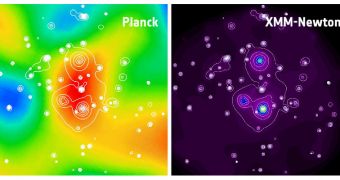The first findings made by the Planck telescope were presented in two separate events held yesterday. Among its chief achievements, the observatory managed to discover some of the coldest objects in space, and also some of the most distant and old galaxy superclusters.
The European Space Agency held a press conference in Paris, France on January 11, while at the same time its representatives were presenting their findings across the ocean, at the winter meeting of the American Astronomical Society (AAS 2011), in Seattle.
Planck, which was launched on the same Ariane 5 delivery system as the Herschel Observatory, on May 14, 2009, observes the Universe and its cosmic microwave background (CMB) at unprecedented resolution, and in great levels of detail.
This is the first batch of data to be released by the Planck Collaboration, the international group of researchers in charge of handling the data the impressive telescope sends back to Earth.
ESA officials believe that the next batch of data will be released no earlier than January 2013. Still, all-sky maps that the telescope will create until then will be released in the mean time.
Most of the findings are detailed in no less than 25 papers, all of which have been submitted for publication in an upcoming issue, or issues, of the esteemed scientific journal Astronomy & Astrophysics.
At the AAS 2011 meeting, scientists detailed some of the findings, such as for example the discovery of the most massive galaxy superclusters in the known Universe. Planck has identified some 189 of them, of which 20 had not previously been observed.
In addition, the observatory looked at some of the coldest, most frigid places in the Universe, and in the Milky Way. Astronomers say that these are areas where the earliest stars were born, but which are now completely depleted of gas.
Planck was able to identify no less than 10,000 cold cores in our galaxy, which astronomers will now use to begin analyzing the start of stellar formation and other related processes. Some of these cold cores have temperatures of just 7 degrees above absolute zero.
At this point, the telescope is returning to its primary mission, which is creating the first high-resolution, complete map of the cosmic microwave background. This is a form of radiation left behind by the Big Bang, which permeates the Universe.
Analyzing it can tell us more about how the first stars and galaxies appeared, about whether the Universe is expanding or not, about superclusters and dark energy, and so on, Science News reports.

 14 DAY TRIAL //
14 DAY TRIAL //